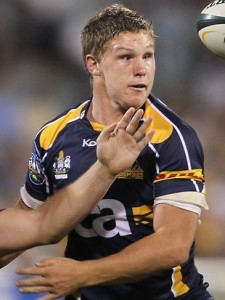
Michael Hooper playing for the Brumbies, before White deemed him surplus to requirements.
When the scholars trawl through history and attempt to unearth the origins of a Waratahs premiership, they may settle on two names.
Michael Cheika and Israel Folau? No? Okay, what about Kurtley Beale, or Nathan Grey?
All those will feature, certainly.
But in the timeline but they’d have to go back further and head 287km south to Canberra.
There they’d find the names Jake White and Ita Vaea, and a moment-in-time conversation between the new Brumbies coach and a kid with six starts called Michael Hooper.
The year was 2011 and Hooper had been at the Brumbies for two seasons; serving as back-up to the legendary George Smith in his debut year.
Given Smith never missed a game, so that meant rare game time for the young Manly boy. He had three starts in five games in 2010 but even after Smith left the Brumbies, Hooper only started another three in 2011.
Julian Salvi (9) and Colby Faingaa (4) both started more games and when White arrived at the Brumbies, he arrived with firm ideas about flankers.
Namely, flankers should all be massive and not, well, not the size of Hooper.
In the South African tradition, the number on a loose forward’s back should, ideally, indicate how many feet tall they are. Six, seven or eight. Didn’t matter. With power at the breakdown the basis of White’s World Cup winning game plan, the bigger, the better.
“Fetchers” were eyed warily in Africa and the first sight of Hooper didn’t inspire White.
The story goes that he called the then 19-year-old into his office.
“I am not sure what to do with you Michael,” White said. “Compared to South Africans, you are only a boy.”
The comment stung, and when the 2012 season rolled around, White’s stuck fast to the Springbok philosophy.
He named 120kg flanker Ita Vaea as the openside flanker in the Brumbies opening round, and kept him in the No.7 for the first three rounds.
The writing was on the wall for Hooper, and he read the message.
Despite the fact White eventually saw the light and started Hooper in round four, discussions with three other states were not only opened, they were well underway by that time.
Hooper liked the idea of returning home to Sydney, where NSW were not only keen on a flyer at No.7, they were perhaps aware the loss of Phil Waugh was about to hit home in 2012. Painfully.
The deal was done and by April, Hooper was signed by the Tahs.
White would see the light when Hooper began to display strong form, and he went on to start in every game thereafter.
But by then it was too late. Hooper was a future Waratah, and each dominant performance was a reminder to White he’d let a genuine star slip.
The South African came to appreciate the role of the Australian-style No.7 so much he reacted to the loss of Hooper by pursuing – and signing – David Pocock to the Brumbies from the Force.
Pocock was still the man, at this point, but Hooper’s name was now firmly on the Wallaby radar, and a knee injury while captaining Australia saw the youngster – snubbed just five months earlier – now wearing the gold No.7.
“It was a worry,” Hooper said later in 2012 on his non-selection by White.
“I wasn’t in the team for the first two (Super Rugby) games, but then I got my shot.”
“We ended up having a really good partnership and he guided me well this year. But yeah, if you have said at the start of the season I’d be playing this game, I’d have said you’re lying.”
“This game” was a clash against the Springboks. He performed strongly in it, and in all his early performances and on the Spring Tour. So much so, Hooper shot up into third on the John Eales medal voting in 2012 despite playing only half of the Tests of most rivals.
He moved north to Sydney and the rest is history for Hooper.
Linking up with NSW and Cheika, Hooper has emerged as Australia’s best rugby player in the past two seasons; Folau included.
He won the 2012 John Eales medal and will be unbackable to win again in 2014. At the age of 22, Hooper this season became Wallabies captain, and assumed the role from Dave Dennis at the Tahs as well.
Comparisons with Smith have been made, and Hooper’s stats more than measure up. In some categories they are superior.
Individual strengths vary, but the measure of any genuine superstar is their ability to influence the result.
The winning percentages of Smith (62%) and Hooper (62.5%) with them playing, are barely indistinguishable for the Brumbies and the Waratahs, respectively. As are their team’s record without them.
But Smith still has something that separates him from Hooper: a Super Rugby title.
Time will tell if that is a temporary discrepancy. A short time.
A bit like HM with Brussouw.
Both JW and HM are plonkers.
@ Loosehead:
Agreed, let history show that as much as Wit “has an eye for spotting talent”, he also farks up as well.
Brumbies’ loss was Waratahs gain although Hooper was going “home”.
Users Online
Total 170 users including 0 member, 170 guests, 0 bot online
Most users ever online were 3735, on 31 August 2022 @ 6:23 pm